Battle of Critia. New losses of the allied fleet
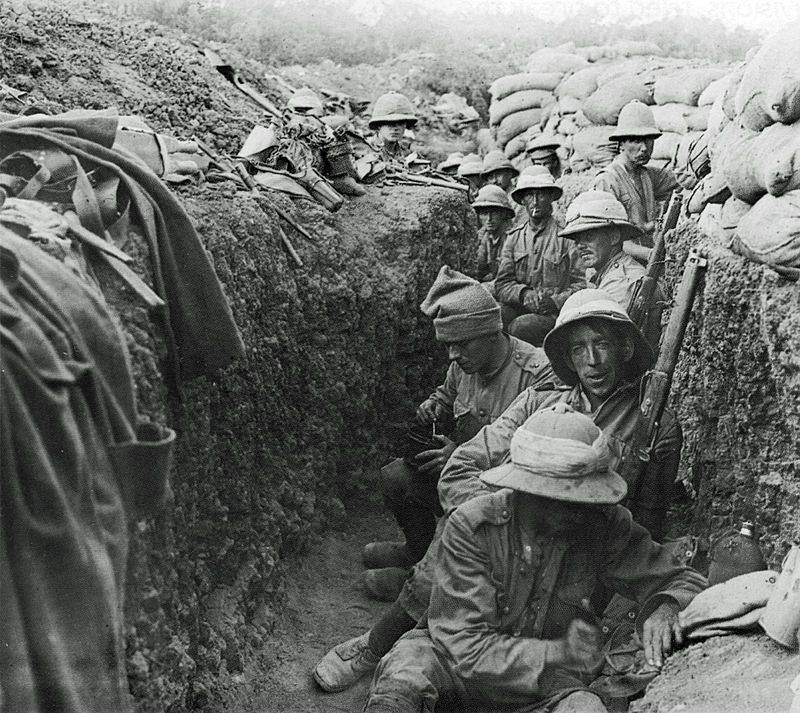
After the landing, the Anglo-French command decided to move deep into the peninsula. The main task of the Allied forces at the initial stage of the offensive was the capture of the village of Crete before the arrival of additional Turkish forces on Gallipoli. 28 April 1915. Anglo-French forces launched an offensive against Critia.
First Battle of Critia
The Anglo-French command, in spite of great losses, decided to continue the operation and take on the Kritia and highlands of Achi-Bab, commanders over the entire surrounding southern part of the peninsula, which was to ensure success against the forts of the western shore of the strait. For the convenience of command, the Allied forces were divided into sectors: 1) the British right-wing flank was the right flank; they were on the beach “S”; 2) the right sector was occupied by parts of the French division of General Masnou, who completed the evacuation from the Asian coast, as well as the rest of the same division that arrived from Tenedos; 3) middle sector - British troops from Sedd-El-Bar and the beach "V"; 4) “W” beach troops, supported by Hindus and marines, made up the left sector up to the Aegean Sea.
It must be said that the Allies had great supply problems, whose questions were not thought out. There was not enough water, the soldiers fed on breadcrumbs and canned food, which they took from the dead Ottomans. The troops were extremely tired from the continuous battles since the landing of April 25. At that time, Turkish troops began to receive reinforcements in the form of units of the 11 and 3 infantry divisions from the Asian coast, where commander-in-chief Sanders ordered only one regiment to be left, and parts of the 5 and 7 divisions from the Bulair Isthmus. As a result, the Allied offensive took place in the most adverse conditions. It is also worth remembering that the terrain was extremely inconvenient for the attackers, but provided good opportunities for organizing defense.
A new offensive was scheduled for 28 on April 1915. The attack by the allied forces began with the support of powerful naval artillery fire. The fire led 10 battleships. In the morning, the Allies occupied the village of Eski-Gissarlik and advanced to the outskirts of the village of Crete, without encountering any special resistance from the enemy. However, Turkish reinforcements from the 9 Infantry Division of the Ottoman army under the command of Colonel Khalil Sami Bey arrived. Turkish reinforcements restored defense strength. In addition, on the right flank, French troops ran into a strong enemy position at Kerevez-dere. Here lay a deep ravine, which was skillfully turned into a strong position with an abundance of wire obstacles, machine-gun points and closed shelters against which ship fire was invalid.
Having received new reinforcements from the fresh units of the 7th Infantry Division, the Turks went on a counterattack. British troops were driven back from Critias. However, the further movement of the Ottomans stopped the Allied fire fleet. After receiving reinforcements, the Allies again attacked. But both the English and the French could not succeed. Turkish troops created a stable defense and repelled all attacks of the allied forces.
Having no more reserves, with the almost complete exhaustion of ammunition, Hamilton ordered to stop the attacks and dig in at the frontier. But as soon as the Allies began to dig in, the Turks again counterattacked and broke through at the junction between the British and the French. Only in the evening, at the cost of great losses and efforts of the French parts, the breach was eliminated.
As a result, the Allies failed to complete the task and capture Critia to continue the offensive further. The 29 Infantry British Division was completely upset by the losses, which reached half of its strength.
29 April and most of the day 30 April, both sides put themselves in order. At Gaba-Tepe, a marine brigade replaced the Australian units, which suffered particularly heavy losses, since they were isolated 20 km north of the British left flank. The Australian and New Zealand Army Corps (ANZAC) constantly reflected the enemy’s strong counter-attacks and the strength of the uncomfortable position, and suffered excessive losses.
29 April another Indian brigade arrived from Egypt. Hamilton Expeditionary Corps was completely planted on the peninsula. In the evening of April 30, the Turks, completing the regrouping of forces, launched a strong attack against the Anglo-French. But it was reflected everywhere with great losses for the Turkish troops.
Thus, the Allies advanced only 6 kilometers from Cape Helles in six days of large-scale amphibious assault operations and suffered heavy losses. The decisive role in the failure of the operation was played by the lack of the necessary superiority in manpower and field artillery. The Allied Command did not have large reserves that could be thrown into battle at a critical moment and turn the tide in their favor. In his report on the failure of Kritia, General Hamilton noted that "if it were possible on this day (April 28) to bring forward reinforcements with people, artillery and ammunition, Critia would have fallen, and many subsequent battles for her possession would have been avoided."
Before Hamilton, the question arose whether to continue the further attack, or to wait for the approach of new troops. England and France finally realized that they were unable to take the Dardanelles and hurriedly sent reinforcements to the straits. The French hastily loaded the 2 Infantry Division into ships in Marseilles. The British transferred all that remained in Egypt - the remaining parts of the ANZAC and the Indian division. In addition, the Allied command sent to the Dardanelles completed the formation of the 42-th division.
British artillery
Turkish counter attack
Meanwhile, the Turkish command completed the transfer from the Asian to the European coast of the entire 11 infantry division and most of the 3 division. In addition, Sanders asked Enver-Pasha to transfer 1, 5 and 12 infantry divisions from the 15 army to the 16 army. The German-Turkish was preparing a big offensive with the aim of dropping the enemy into the sea. Liman von Sanders, given the fact that the Turkish troops suffered from a shortage of artillery (six 75-mm batteries per division), that the enemy’s flanks rest on the sea and cannot be bypassed, that the Allied forces have a higher density of battle formations (one infantry division on 1 1 / 2 km), decided to attack at night.
At 10 in the evening of May 1, when the Turkish army had already received some reinforcements, the Turks launched a decisive attack on the entire southern sector. The English troops stationed at Kritia retreated. Turkish troops again broke through the junction of the British and French and deeply broke into the location of the allies. Only in the early morning the Allied forces were able to stabilize the front. The Turks were thrown back to their former positions and suffered heavy losses. In only one 15 division, 4 thousand people were killed and wounded. This failure led to the fact that the German-Turkish command decided to go on the defensive and focus on strengthening the fortifications.
Hamilton, receiving reinforcements in the form of an Indian brigade and marines, decided to use the opportune moment, taking advantage of the failure of the Turkish offensive and attacking again, until the enemy regained his strength and created a strong defense. The Anglo-French attack was quickly organized with the support of the fleet. However, the Allies could only finally restore the old front. Break through the Turkish defense failed. Hamilton wrote: “if there were not these devilish inventions here, which are called machine guns and barbed wire nets, I would take Achi-Baba that day”.
On the night of May 4, the Ottomans went on the offensive again, using all available reserves. However, this attack also failed. After that, the Turkish command finally abandoned the general offensive, moving to the defense.
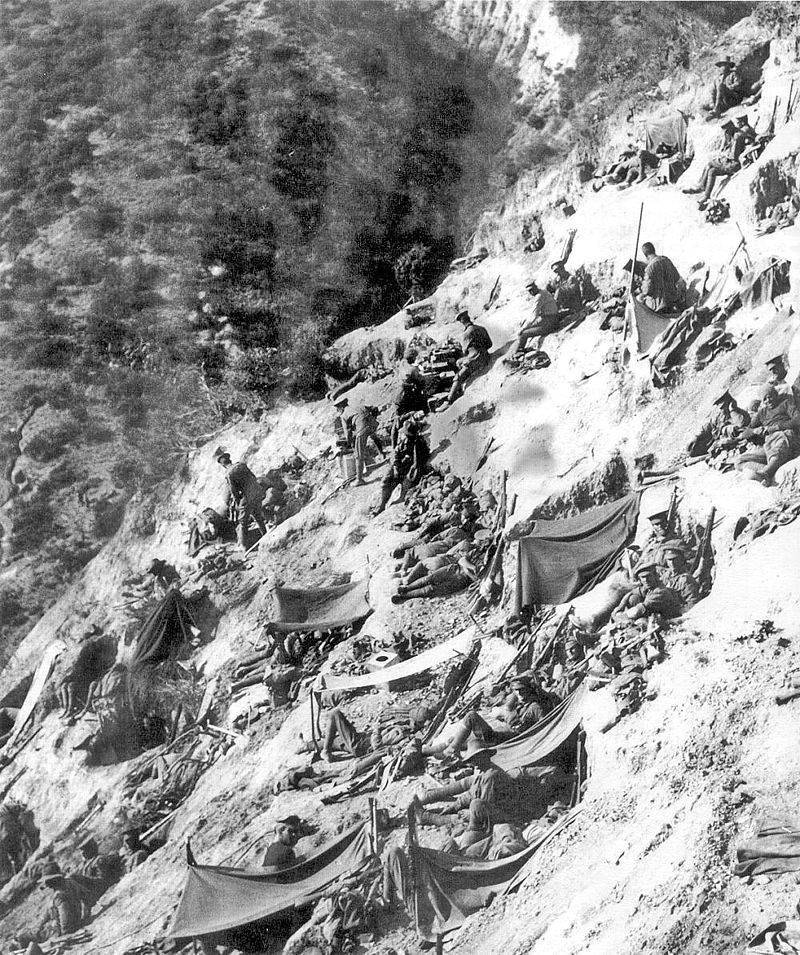
ANZAC in May 1915
Second Battle of Critia
Hamilton was still hoping to break through the Turkish defense and organized a new offensive. The Allied Command had practically no idea about the system and depth of the Turkish defense. Aerial reconnaissance did not produce the expected results, so the artillery preparation before the attack was not effective. They refused from the night attack, because the troops knew the terrain poorly and could get lost.
On May 6, British troops, after half an hour of artillery preparation, attacked Kritia from the west and southwest. The French again attacked in the area of the ravine Kerevez-Dere. The Allies advanced slightly, taking several forward positions. On the second day, May 7, the Allies attacked Kritia again. Naval artillery actively supported the ground forces, especially in the center and right flank. Here the Turks went to Kritia itself. But on the left flank, despite the support of the fleet, and the input of reinforcements, the British were almost unable to advance. The Allies suffered heavy losses. Evacuation of the wounded and medical assistance were poorly organized, the wounded were in the most difficult conditions, waiting for the evacuation, many died without waiting for help.
Thus, the second attempt of the Anglo-French troops to seize the village of Kritia and the height of Achi Baba during the Dardanelles operation was not successful. In the course of the bloody and stubborn battles against the Turkish troops, the Allied forces managed to occupy a small territory, but the objectives of the operation were not achieved and the British could not take Kritia and heights.
Ottoman soldiers
Further fights
The Turkish command decided to conduct an operation against the Australian corps, using for this purpose the selected 2 th infantry division sent by Enver Pasha from Constantinople. 16 May 2-I Infantry Division arrived at the scene. Prior to this, the 19 and 5 Turkish infantry divisions stood against the ANZAC, with the 16 infantry division in the second line. For the upcoming operation, the Turkish command of the left flank strengthened the 16 division, and the center - the 2 division. The main attack was inflicted by the 2 Infantry Division in the center. Thus, the Ottoman command prepared a strike force consisting of four divisions (42 thousand bayonets). Australian and New Zealand troops numbered 20 thousand people at this moment.
The offensive began at 3 hour. 30 min. 19 May bayonet attack, without artillery preparation. The 19-I and 5-I infantry divisions achieved partial success with a strong blow, the attacks of the 2-th and 16-th infantry divisions did not lead to success. In the morning the Turkish troops resumed the offensive. However, each time the Ottomans were stopped with rifle, machine-gun and artillery fire. Turks were literally shot from rifles, machine guns and cannons, and they went on the attack without a shot. The left flank of the Australian corps made a counterattack and threw the Turkish division's 19 to their original positions. Despite heavy losses, the Turks continued bold attacks until the 15 hour. 30 min. Then the ANZAC units, supported by shipfire, went over to the general counteroffensive and drove the enemy back to their original positions.
Thus, despite the double superiority, the Ottomans could not throw the Allies into the sea. Both sides showed heroism and courage in this battle. Turkish troops suffered heavy losses. The 2 Division was almost completely wiped out - 9 thousand people killed and wounded. The ANZAC units that were shot by the enemy from fortified positions were lost to 600 people.
After this failure, the Turkish command again for a long time abandoned offensive operations, making sure that it was impossible to overcome the enemy’s resistance without heavy artillery and a large expenditure of ammunition. In addition, in order to avoid unnecessary losses from the fire of the Allied fleet, which gave a great advantage to the Anglo-French troops, Sanders ordered the construction of durable shelters in the second line of defense. At the same time, the Turks pushed the first line as far as possible to the enemy, so that the Allies, in fear of hitting their troops, would stop firing ships along the leading edge. At night, the Turks advanced trenches in many places on 300 from the Anglo-French positions. This led to the beginning of the trench warfare, with the use of hand bombs, grenades, the constant front swing of tens of meters back and forth, when the fight was literally over every meter of territory.
After that there was a pause, there were no decisive battles. Both sides waited for the arrival of large reinforcements, after which they planned to launch a decisive offensive.
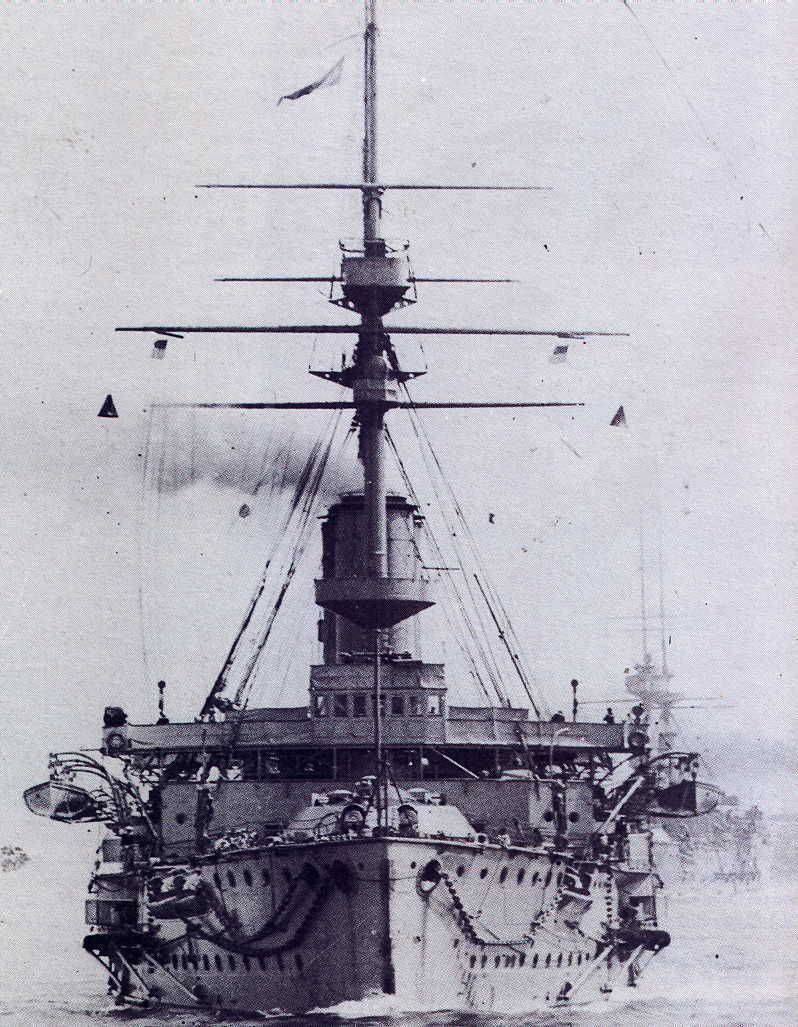
British battleship "Goliath"
Losses at sea. Union Fleet Retreat
During this period, events occurred at sea that worsened the position of the allied fleet. Turkish batteries sank several small transports, a significant number of small vessels and several destroyers. The Turkish destroyer “Muawenet-i-Millet” with impunity drowned the British squadron battleship “Goliath” (Goliath) at night with three torpedoes. The British battleship died with the entire crew.
After this tragedy, the ships of the Allied fleet no longer became anchored near the coast. In addition, the Allied command received the news of the appearance in the Mediterranean Sea were Germanic submarines. Fleet security was enhanced. Fleet ships were ordered not to go to sea without protective nets, but this did not help. On May 25, the German U-21 submarine sank the British Triumph squadron battleship. The torpedoes cut through the nets and caused a kryuti camera explosion The battleship sank in 20 minutes.
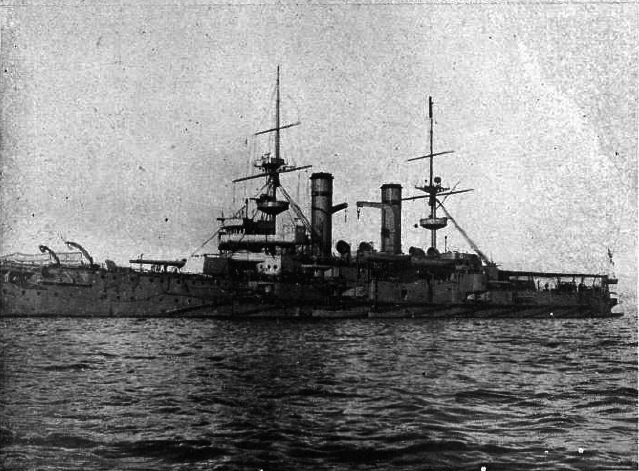
British ship "Triumph"
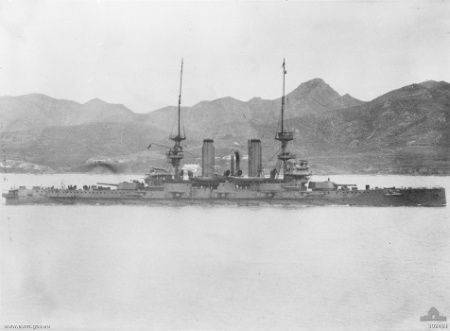
"Triumph" in Gallipoli
27 May 1915, the third battleship died. About 06 hour. 45 mines, Otto Hersing, the commander of the German submarine U-21, gave the order to make a torpedo volley at the British Majestic squadron battleship (Majestic), followed by a huge bright explosion. The ship began to lurch and after nine minutes turned over and went into the water, 49 crew members died.
These events greatly alarmed the Allied command, which feared new losses. Especially feared for the fate of the newest dreadnought "Queen Elizabeth." The ship was recalled to English waters for repairs. Soon the Dardanelles were left with only the old ships, which tried to protect in all possible ways. The Allied fleet seriously reduced its activity in bombarding the Turkish positions and supporting the ground forces. All transports were collected in the harbor of Imbros Island and in the Bay of Mudros. With the help of a large number of small vessels and minesweepers sent from England and France, special fleets were formed to observe and perform guard service.
Soon the fleet was almost completely out of battle and anchored in Mudros raid. As a result, the expeditionary Dardanelles Corps, which was supposed to support the fleet according to the original plan, was left alone. He was supported by fire with only two 240-mm batteries installed by the French at Sedd-el-Bar and Eski-Hisarlik and several British heavy batteries at Kritia. If the Turks had a sufficient amount of heavy artillery and ammunition, the position of the expeditionary corps would be unbearable. Allies would be on the verge of defeat. However, the long-term military backwardness of Turkey affected. If the selected Turkish units could still fight on equal footing with the allies, then the industry could not supply the troops with everything they needed.
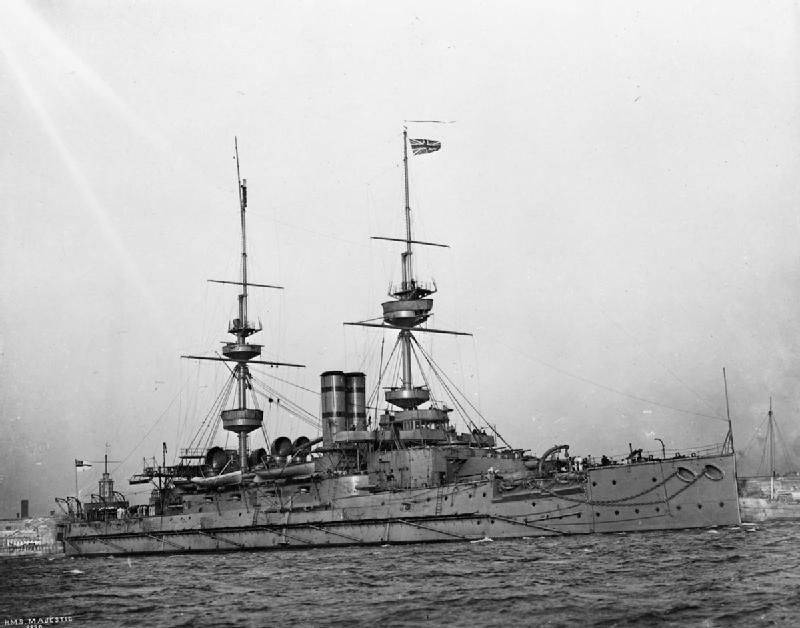
British battleship Majestic ("Majestic")
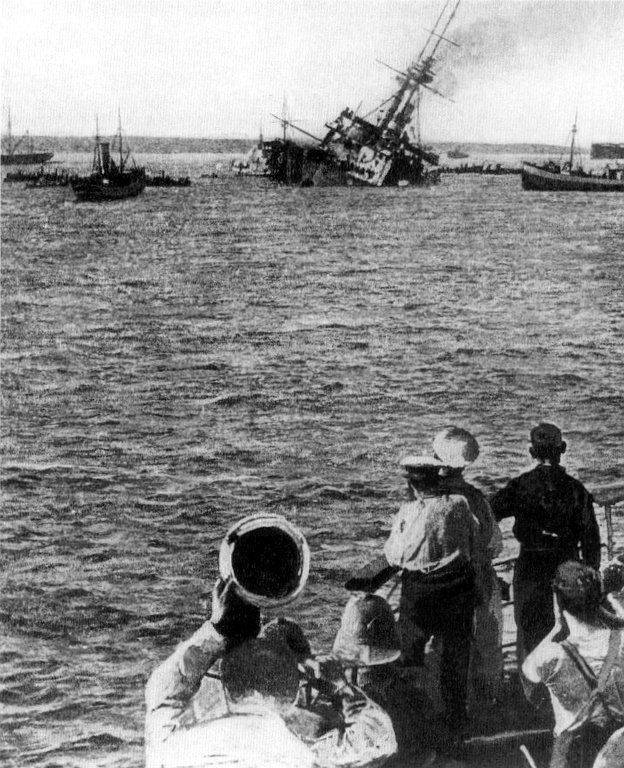
The death of the ship 27 May 1915
To be continued ...
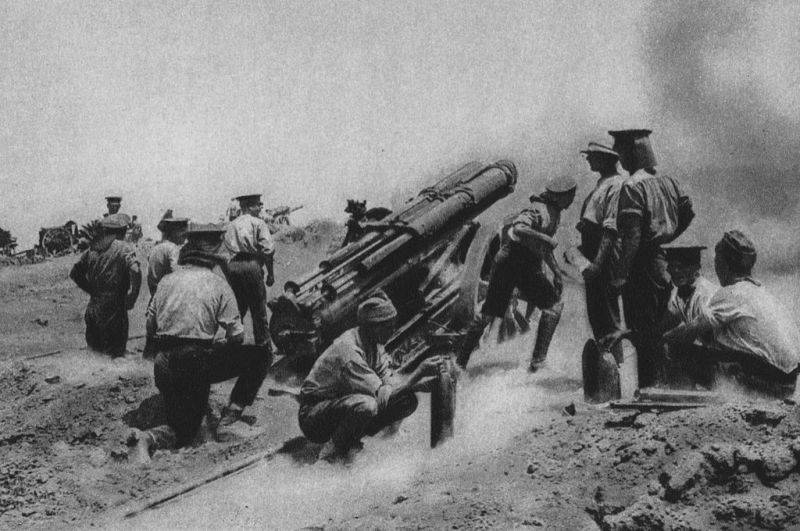
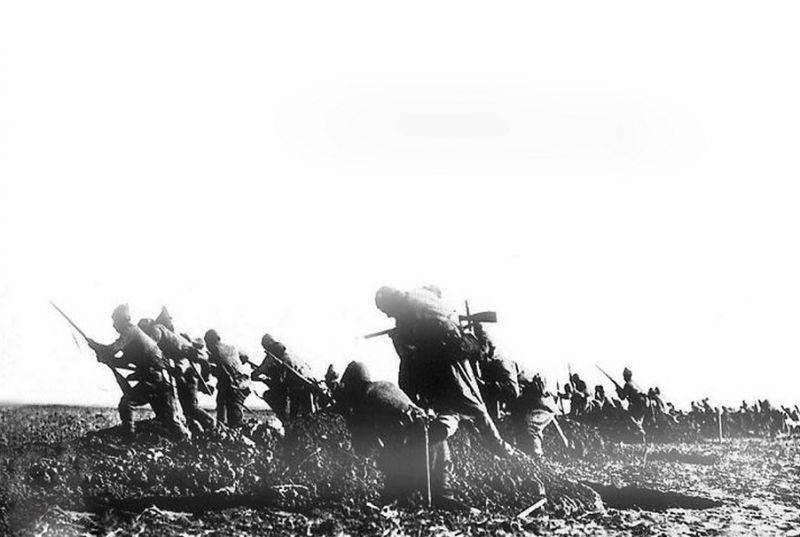
Information